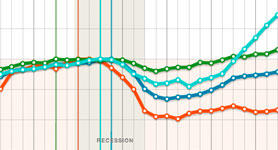State Tax Revenue Hits New Peak
These data have been updated. To see the most recent data and analysis, visit Fiscal 50.
For the first time, total state tax revenue appears to have recovered from its plunge in the Great Recession. Receipts for the 50 states combined were 0.5 percent higher in the second quarter of 2013 than at their collective peak in 2008 after adjusting for inflation. But recovery was uneven; only 20 states were above peak.
For every $1 that states collected at their tax revenue peak in the third quarter of 2008, they took in just half a cent more than $1 in the second quarter of 2013, after adjusting for inflation and seasonal fluctuations. That is up from 98.4 cents in the prior quarter and amounts to the first increase in purchasing power from overall state tax dollars in nearly five years.
Based on the latest preliminary figures, the results represent a milestone but fall short of erasing the recession’s effects.
In 30 states, tax collections still were below their own peak levels. In 11 of those, receipts were lower by 10 percent or more. The difference between current and peak quarterly tax revenue—based on four-quarter moving averages—is a gauge of the financial stress still burdening state budgets after the recession.
States Where Tax Revenue Has Recovered |
|||
| State | Percent above peak, 2Q 2013 | ||
| North Dakota | 91.0% | ||
| Illinois | 20.3% | ||
| Minnesota | 15.6% | ||
| New York | 9.7% | ||
| Iowa | 8.8% | ||
| Texas | 7.3% | ||
| Colorado | 6.9% | ||
| Hawaii | 6.0% | ||
| Vermont | 5.8% | ||
| Arkansas | 5.1% | ||
| South Dakota | 4.3% | ||
| Delaware | 3.0% | ||
| Nebraska | 3.0% | ||
| Connecticut | 2.4% | ||
| Wisconsin | 2.4% | ||
| Oregon | 1.6% | ||
| West Virginia | 1.2% | ||
| Tennessee | 1.0% | ||
| California | 0.8% | ||
| Nevada | 0.7% | ||
|
Source: Pew analysis of the U.S. Census Bureau’s Quarterly Summary of State and Local Taxes, as adjusted by the Nelson A. Rockefeller Institute of Government. |
|||
Even if states return to their previous peaks, it does not necessarily signal an economic comeback. Growth can result from tax increases or other policy changes. In recent quarters, total tax revenue was boosted by some one-time receipts, including money from taxpayers who accelerated income to avoid a federal tax hike. A return to peak levels still can leave states with little extra to make up for cuts in federal aid or to pay for costs associated with population increases, growth in Medicaid enrollment, deferred needs, and accumulated debts.
As of the second quarter of 2013, which is the end of the fiscal year for most states:
- North Dakota’s tax revenue was 91 percent above its highest point during the recession, thanks to an oil boom that sent severance and sales taxes soaring.
- Alaska was the state furthest from its peak, down more than 51 percent. Its 2008 high point was the short-lived result of a major state oil tax increase that took effect just as crude prices spiked to an all-time high. The next-largest gaps between current and peak tax revenue were in Wyoming (-26.9 percent), Florida (-21.1 percent), and New Mexico (-20.7 percent).
- Five states’ tax revenue rose above peak for the first time, after accounting for inflation: California, Connecticut, Nebraska, Nevada, and Oregon.
- Two states accounted for more than half of the increase that drove total tax revenue above peak in the quarter: California (39.5 percent) and New York (12.4 percent).
Without adjusting for inflation, quarterly state tax revenue was 7.7 percent above peak overall and had recovered in 35 states. These figures do not account for other factors affecting states’ budgets, however.
Adjusting for inflation is just one way to evaluate state tax revenue growth. Different insights would be gained by tracking revenue relative to population growth or state economic output.
Correction: An earlier version of this analysis described the latest tax revenue total as giving states $1.05 for every $1 they collected at their revenue peak in 2008. The correct equivalent is a half cent more, not five cents more.
Analysis by Barb Rosewicz and Alex Boucher
To see the most recent analysis for Fiscal 50, please visit our overview page.







